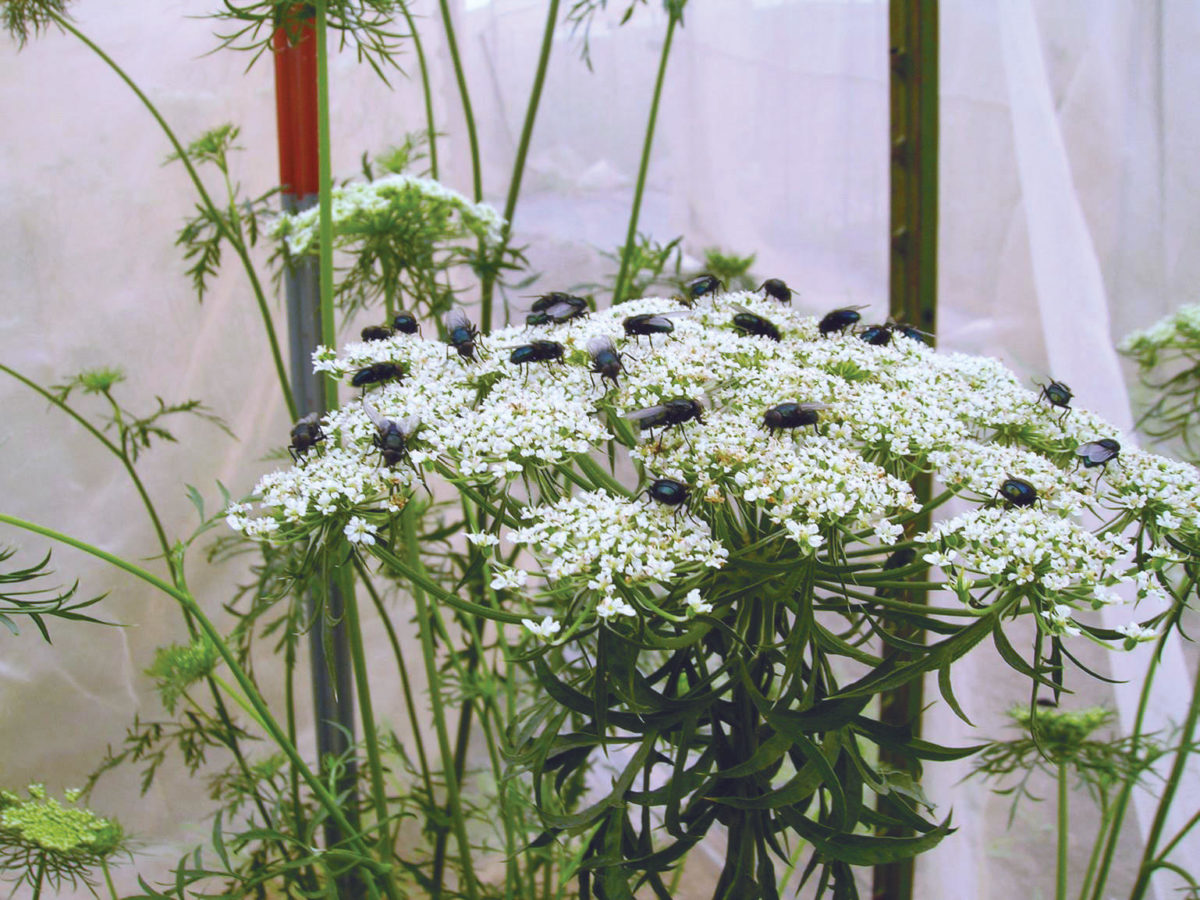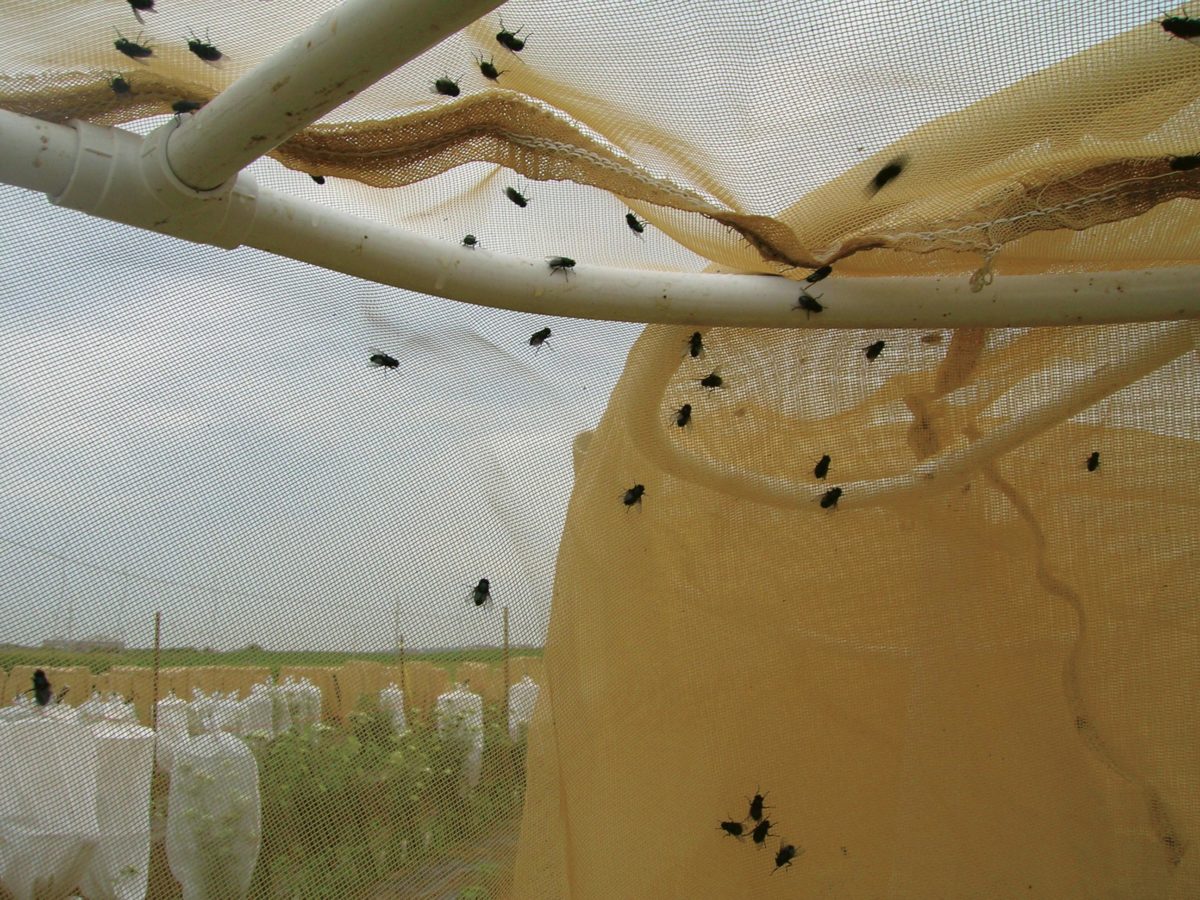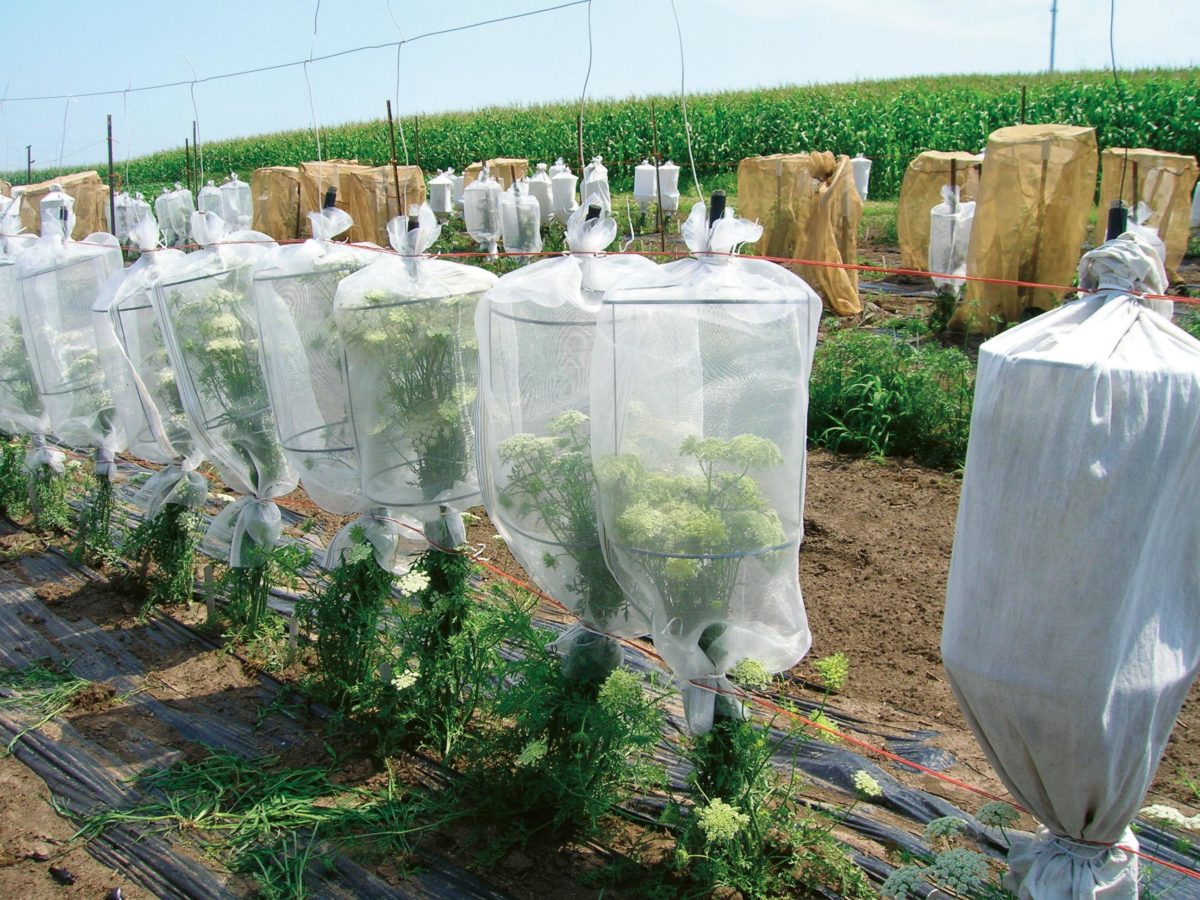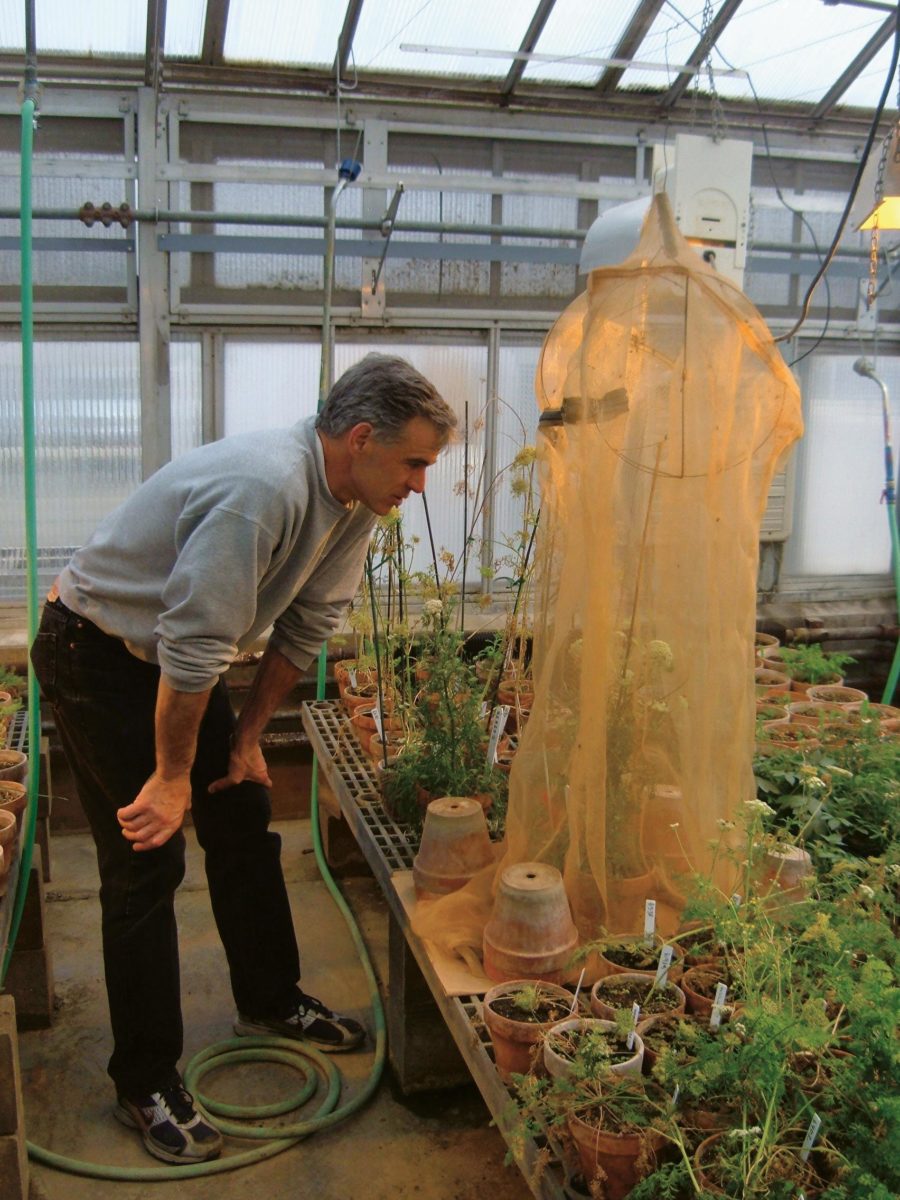(Calliphora vomitoria)

With the unsettling scientific name of Calliphora vomitoria, the common blue bottle fly is perhaps our most unusual managed pollinator (Figure 8.6). Even to describe the blue bottle fly as a “managed pollinator” is to stretch the definition of the term since the fly is only an incidental pollinator, and its management practices are minimal. Yet for certain plant breeding operations, the blue bottle fly is an effective and important alternative to bee pollination.
As a member of the Calliphoridae, or blow fly family, the blue bottle fly is often considered a nuisance. Its associated foods—rotting flesh and dung—give the insect a reputation for spreading disease. However, these dietary habits also serve to keep the world clean and to recycle nutrients. The larval maggot stage of flies uses the protein in these foods for development. Female adult flies also consume a small amount of these foods as a protein source for the development of mature eggs within their ovaries. The primary fuel source for flight activity in adult flies, however, is sugar—such as that found in flower nectar. It is this dietary requirement that can be harnessed for managed plant pollination.
Currently the use of managed blue bottle flies has been limited primarily to vegetable breeding programs, particularly members of the carrot family, including carrot, parsnip, dill, and celery.
At about 1⁄2 inch in length (12.7 millimeters), the blue bottle fly is slightly larger than the common house fly (Musca domestica). Blue bottle flies have conspicuous red eyes and short blunt antennae. The head and thorax are a nondescript gray color, and the abdomen is metallic blue. While they do have patches of short hair covering their body, flies do not have any special pollen collecting structures, nor do they actively gather pollen. While some pollen grain inadvertently stick to them while feeding on nectar, blue bottle flies are not optimized for large-scale movement of pollen.
Also unlike bees, flies do not construct or provision nests for their offspring. As a result flies have no special homing instinct and will not return to specific flowers or locations. Their use as managed pollinators is therefore restricted to cages, screened rooms, or sealed greenhouses that prevent escape (Figure 8.7). Typically these pollination scenarios involve specialized breeding programs utilizing small batches of isolated plants. In these sorts of confinement situations, bees may become sullen and refuse to forage, or need supplemental food sources. In close quarters confinement, flies may also be preferable to bees due to stinging concerns. In addition, depending on the time of year, certain bee species may not be available or may require artificial incubation and lifecycle manipulation for adult emergence. Flies on the other hand are readily available from professional rearing facilities year-round. These insectary-reared flies are very low cost, and are typically reared in sanitary conditions to prevent the spread of infectious disease. Purchased flies are usually shipped as pupae ready for emergence, sometimes in heated shipping boxes, which act as incubators (see sidebar).

Rearing procedures for blue bottle flies are well established. Captive adult populations are maintained in screened cages. These adults can either be procured from established producers or wild collected. Rearing room conditions are typically maintained at around 78°F (~25°C) and 30 to 40 percent relative humidity. A daily cycle of 14 hours of light and 10 hours of darkness seems to be preferable.
Adult flies are provided water at all times through cotton dental rolls that wick water from an enclosed reservoir. A provision of honey is also maintained at all times, and is changed twice weekly as needed to prevent spoilage.
In addition to the water and honey, adult flies require a supplemental food source to promote egg laying. A recipe used by the USDA-ARS North Central Region Plant Introduction Station (NCRPIS) in Ames, Iowa consists of 35 milliliters corn syrup mixed with 10 grams of dry powdered egg, and 1 teaspoon alphacel (a food grade cellulose product). These ingredients are mixed to form a sticky paste that is provided to the flies in a petri dish and covered with a plastic mesh screen as a feeding platform. Fresh food is provided weekly as necessary.
Adult females lay their eggs on a larval food source, typically beef organs such as small pieces of raw liver, roughly 3 inches x 3 inches (7.6 x 7.6 centimeters). To provide additional egg laying surface area, the liver may be scored deeply with a knife. It is then placed into a Petri dish and placed into the cage containing adult flies. The NCRPIS recommends placing this Petri dish in a shaded or covered area within the rearing cage to further encourage egg laying. The eggs are slightly over one millimeter in length, and a female fly may lay up to 200 at one time. Hatching time requires about one day under warm indoor temperatures.
After 24 hours the piece of liver is removed from the rearing cage and transferred to a second Petri dish containing a larval food source that is less prone to spoilage. The NCRPIS uses a diet containing 180 grams of blood meal, 120 grams dried egg, 120 grams dried milk, 6 grams sorbic acid, and 6 grams methyl paraben. The last two ingredients act as preservatives. These dry ingredients are premixed, and will produce about three liters of finished larval food.
To prepare the larval food, 54 grams of agar is mixed with 1.8 liters of distilled water and cooked in a microwave until the solution turns gold in color and is bubbling from the bottom. This is then poured slowly into a large laboratory blender containing 2.25 liters of distilled water (which serves as a cooling agent). This mixture is blended together and the dry ingredients are then added. After further blending, 3 milliliters of propionic/phosphoric acid solution is added. This acid solution acts as a fungicide in the final product, reducing spoilage during larval feeding. Extreme care should be taken when handling this, and all other ingredients, and appropriate protective equipment such as gloves, goggles, and aprons should be worn.
After several minutes of mixing, this is poured into Petri dishes, covered with clean paper towels, and allowed to dry. Drying may take up to one hour. After the diet is solid, and no moisture remains, it can be covered with a plastic bag and stored in the refrigerator. To allow the acid solution to combine with the other ingredients, it should not be fed to the larvae until 24 hours have passed following preparation. It should also be warmed to room temperature before it is transferred to the rearing cage.
Before preparation it is essential that all cookware, countertops, and utensils are sterilized with a weak bleach solution.
After about 24 hours the first larvae appear. These larvae then develop through three growth stages, called instars. Each instar is separated by a molting event. At this stage the maggots are white with black mouth hooks that are used to tear flesh while feeding. Enzymes are also secreted to help break down food sources during the feeding process.
Upon hatching the small first instars begin crawling in search of additional food. During this stage the raw liver is placed directly on top of the manufactured larval food source in a smaller dish—after the larvae move to the manufactured food, the original liver can be removed. Additional manufactured food is supplied as needed. Moldy food should be discarded.
Feeding maggots are maintained in tightly screened containers. In the search for food and pupation areas, maggots may climb throughout the container where they will discover any potential escape holes.
After a week or more of feeding, the larvae begin pupation. In nature, fly maggots burrow into the soil and remain covered with tough brown cocoons while they develop into adults. These pupae may remain dormant over winter during cool weather; however, in warm conditions, they will emerge as mature adult flies in two to three weeks.
In the rearing facility, after a week of active feeding on the manufactured larval food, vermiculite is added to the floor of the rearing cage forming a layer about 1 inch (2.54 centimeters) deep. Pupation will then begin as the maggots burrow into vermiculite. After an additional five days this vermiculite is then chilled for 24 hours in a 40°F (4.4°C) refrigerator. Pupae are then separated from the vermiculite using a series of screened trays.

Upon separation from the vermiculite, pupae can be added directly to pollination cages for emergence within several days (Figure 8.9) individual female fly may lay up to 2,000 eggs over her lifetime, which is typically about one month. The sex ratio of these eggs is usually 50:50. The rate of development and emergence is very much temperature dependent with temperatures from 75° to 80°F (24° to 27°C) producing rapid maturation.
If bloom times are delayed, or if adult flies are not needed immediately, pupae can be stored for several weeks at 40°F (4.4°C) to delay emergence. For each day of cold storage, emergence may be delayed by several days.
Blue bottle flies are widespread throughout North America; however, these rearing procedures may require modification depending on local conditions. In particular, low-humidity climates may increase pupal mortality under storage conditions. Inthese situations, additional humidity sources may be required to prevent desiccation of dormant cocoons.
Fly Pollination: A Plant Breeder's Perspective
When Rob Kane (Figure 8.8) began breeding carrots for the USDA-Agriculture Research Service in Madison, Wisconsin, honey bees were the pollinator of choice. But there were problems.

To prevent pollen contamination by wild carrots or carrots of the wrong variety, the plants are grown in screened cages. “The bees always seemed depressed or hungry in the cages,” Rob says. “They spent a lot of time fanning themselves to keep cool during hot weather, and they didn’t really work the flowers.” To further complicate matters, Rob’s field assistants were afraid of getting stung by the honey bees, so maintenance tasks inside the cages—like weeding—were often ignored.
And the bees were expensive. A single honey bee nuc (a miniature bee hive), rented from a local beekeeper cost $80. With dozens of large screened cages in need of individual nucs, the costs quickly added up.
Rob’s department had a small basement facility for rearing houseflies (Musca domestica), which were used for pollination in the greenhouse during winter months. The small houseflies, while adequate, were also less than ideal—especially for the big outdoor cages during the summer when a lot of pollen needs to be moved between plants quickly.
When Rob tried blue bottle flies from an outside vendor, he was impressed. “You see all those flies working that flower,” Rob says pointing to a single carrot flower covered with nearly a dozen flies. “That’s what a seed-man wants to see.” The larger blue bottle flies have numerous advantages: they have a natural affinity for umbelliferous flowers like carrot; they don’t sting; they are available on demand through overnight shipping from the supplier; and they are inexpensive. “I think we figured the cost out once to be about four flies to the penny,” he says.
Just like other pollinators, blue bottle flies have their limitations. “You have to watch them during really hot weather, and give them a little water. Their lifespan in the field is about 10 days; then you have to restock them. We usually just add about a handful a week to the large 12 feet x 12 feet or 12 feet x 24 feet cages during flowering.” (3.7 meters x 3.7 meters or 3.7 meters x 7.3 meters) Aside from that, the flies are maintenance free, allowing Rob to focus on his real task—producing better carrots.
Contact Rob Kane
Agricultural Science Research Technician
USDA-ARS Vegetable Crops Research Unit
(608) 262-2168
rtkane@wisc.edu
Rob’s fly vendor:
Forked Tree Ranch
HCR 60, Box 226
Porthill, ID 83853
(208) 267-2632
